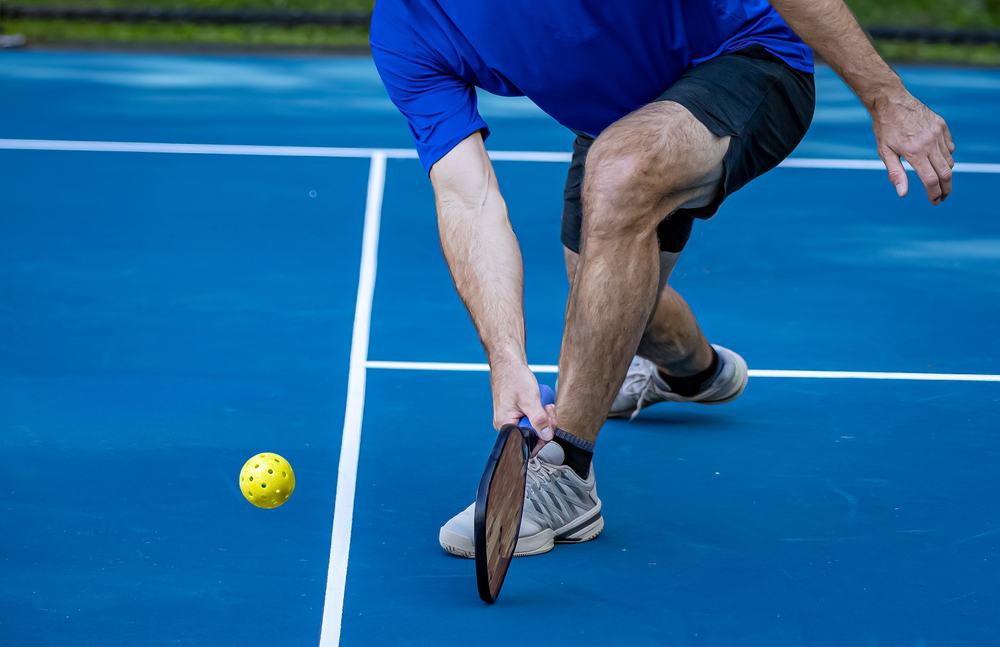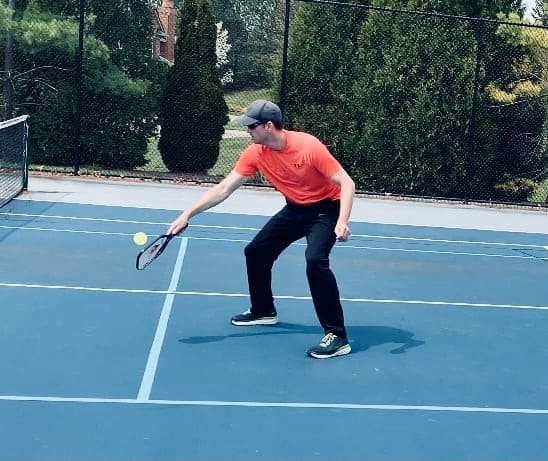What is the Double Bounce Rule in Pickleaball?
When I first started playing pickleball, I needed time to get used to the double bounce rule. But if you’re wondering what the double bounce rule is all about and want to know what the true purpose of the rule is, then you are in the right place.
Key Takeaway:
The double bounce rule dictates that the serve and the return of serve must bounce before players hit them. Once players let both shots bounce, they achieve the two-bounce rule, allowing each team to hit the ball on the fly.
This eliminates the serve and volley advantage seen in other racket sports. It also forces each team to hit groundstrokes before being able to hit the ball out of the air; also known as a volley shot.
Designing the Double Bounce Rule:
The double bounce rule is designed to:
- Require the serve to bounce
- Require the return of serve to bounce
- Organically extend the game for more rallies and longer play
- Even the competition level to some degree
- Mitigate the unfair advantage given to the serving team
If you’re a new pickleball player, chances are you’ve forgotten about the double bounce rule from time to time and cost your team a point.
If you’re a former tennis player, it goes against every court-based instinct you have to not charge the net after you blast a serve to your opponent. But trust me, in pickleball, it serves a unique purpose…and it’s pure genius!
Read on to learn more.
But First – Why Trust Me?
As a seasoned 3.5 level player, my goal is to clarify these key rules. Understanding the nuances of the double-bounce and two-bounce rules not only elevates your game but deepens your appreciation for pickleball’s complexity.
This paddle is the most forgiving paddle I've ever played with and has a HUGE sweet spot!
What Is The Purpose Of The Double Bounce Rule?
Pickleball is designed around rallies to extend the game and make it enjoyable for all ages. Without the double bounce rule, this simply wouldn’t be possible.
If players could play serves and returns of serves on the fly (without bouncing), they might end the point in two or three shots. This implies that a weak serve or return of serve could lead to an easy point at the kitchen line by taking advantage of it and putting it away.
If points, in pickleball were only 2-3 shots each, the game wouldn’t be much fun, would it?
Everyone loves a good rally in almost any racquet sport. And the double bounce rule in pickleball amplifies that in a perfect way. In short, the double bounce rule creates more rallies.
Editors Note: Looking for a paddle upgrade? Click here for my current favorite and one that helped improve my game.
Who Benefits From The Double Bounce Rule?
As I mentioned above, forcing the serving team to let the return of serve bounce keeps them from getting to the net quickly. After the returning team hits, they can (and should) hustle to the kitchen line quickly.
The serving team must wait for the ball to bounce before they hit it a second time. Thus, this single shot effectively delays them before they can even consider charging the net.
This one rule single-handedly removes the big advantage in tennis that legends like Pete Sampras and John McEnroe utilized. Those Hall-of-Farmers would unleash a lethal serve onto their opponent, then dash to the net to put away the point after their opponent barely managed to return their rocket of a serve.
The Double Bounce Rule = No Serving Advantage
In pickleball, because of the underhand serve and more importantly, the double bounce rule, the serving team does not have an extreme advantage. This is one of the rules of pickleball that make it so unique compared to other paddle sports.
Un-returnable serves in pickleball are rare because they’re all done underhand. A deep return of serve virtually denies the server’s chance to reach the no-volley zone and end the point. No Pete Sampras two-shot winners here. No sir, it’s an even playing field in pickleball.
You could argue that because of this rule, the return-of-serve team has the slight advantage of getting to the net first. Most pickleball points are won and lost at the kitchen line, giving an edge to whoever arrives there first. This forces the player or team serving to have to work to achieve that point.
Fun Fact: Only the serving team can earn points in pickleball.
If you’re on the return team, you can’t earn a point but, you can usually get to the kitchen line first. This is huge! It’s a clever little rule, that extends the overall match and makes the game beautifully competitive regardless of age or skill level.
The pickleball double bounce rule effectively removes the serve and volley strategy and makes rallies longer. This is one of the aspects that makes pickleball so much fun and addictive.

Are the “Double Bounce Rule” And The “Two Bounce Rule” The Same Thing?
Yes. Sort of. Let me explain.
In 2018 the official pickleball rules book changed the wording of the double bounce rule an now officially calls it the “two-bounce rule”. But it means the same thing. It’s the rule enforcing that the ball must bounce once on each side before hitting it out of the air (volley) is legal.
Whether you see it referred to as the “double bounce rule” or the “two bounce rule” it means the same thing. It’s referring to the serve and return of serve bouncing.
However, there is some common racquet sport terminology worth mentioning here. You might hear racquet or paddle sport athletes refer to a “two-bounce” rule. This refers to the rule that ALL racquet/paddle sports have where no ball can bounce twice.In this instance, if you allow the ball to bounce twice, the point is over. Or more specifically, a second bounce means a fault has been committed.
Related: I created this easy guide to the difference between the “Double Bounce Rule” and the “Two-Bounce Rule” found in all racquet or paddle sports.
Can The Ball Bounce Twice In Pickleball?
If you’re wondering how many times the ball can bounce in bounds during a game of pickleball, the answer is once. In most racquet or paddle sports, a ball bouncing twice awards a point to the team or player who hit it.
During a game of pickleball, the point is lost if you can’t get to a well placed dink that bounces twice.
Virtually all racquet and paddle sports have this rule. Don’t confuse this common racquet sport rule with pickleball’s double bounce rule.

Who Invented The Double Bounce Rule?
Pickleball’s origin story is a fascinating tale. The game’s founders are Joel Pritchard, Bill Bell and Barney McCullum. But who invented the double bounce rule in pickleball? Was it one of these three famous men?
Unfortunately, the answer to this question isn’t clear. A simple search doesn’t yield any clear-cut answer as to who came up with the most genius rule in racket sports history.
But, since Joe, Bill and Barney worked for days to finalize and customize the rules of the game at their vacation home in Bainbridge Island in Washington so that all of their family members could play – chances are really good it was one of them. Sadly, we may never know.
Update: I’ve reached out to the USAPA for an official answer but I’ve yet to hear back.
Is Pickleball The Only Sport With A Double Bounce Rule?
Surprisingly, pickleball is not the only paddle sport that enforces a double bounce rule where the return of serve must bounce. In Pop Tennis, more specifically “Classic Pop Tennis” the serve and return of serve must bounce before either team can approach the net. Just Iike in pickleball.
For more on Pop Tennis and what it is, check out the article I wrote explaining the differences between it and pickleball. Click here.
What is the Double Bounce Rule – My Final Thoughts
All in all, implementing the two-bounce rule was a brilliant move when Joel Pritchard and his friends began forming the official rules for the game.
Little did they know that a simple rule to take away any blatant advantage to one side would end up being the most clever rule ever designed in a racquet or paddle sport. Thanks for reading, I hope this article helped you.
Double Bounce Rule – FAQs
Q: How does the double bounce rule work?
A: The double bounce rule requires that the ball must bounce once on the serving side of the court and once on the receiving side. This must happen before players are allowed to hit the ball out of the air. This rule is one of the fundamental rules in pickleball.
Q: Why is the double bounce rule important in pickleball?
A: The double bounce rule is important in pickleball as it eliminates the serve-and-volley advantage and ensures that both teams have an equal opportunity to return the ball. It also adds an element of strategy and fairness to the game.
Q: When does the double-bounce rule come into play?
A: The double bounce rule comes into play immediately after the ball is served. The return team must let the ball bounce, and the serving team must let it bounce.
Q: What happens if a team violates the double bounce rule?
A: Violating the double bounce rule by hitting the ball early results in a fault. Then the opponent wins the point.
Q: Are there any exceptions to the double bounce rule?
A: The double bounce rule is fundamental in pickleball. Players must let the ball bounce twice before hitting it; no exceptions.
Q: Where can I find the double bounce rule in the rule book?
A: The double bounce rule is outlined in the pickleball rule book under the section entitled “Two-Bounce Rule”. It covers the sequence for beginners on page 2.
About Me
I’m just a lover of all sports that involve a racquet, net and a ball. My whole family loves and plays pickleball regularly. I launched this site to offer performance tips and buying info for informed purchases.
I have researched, analyzed, compared, and often bought, worn, or used the products I recommend here. If it’s a bad product, I don’t recommend it. Purchases made from this site earn me a small commission, funding site growth to offer more helpful information.

Welcome to TheVolleyLlama.com. My name is Keith, I’m just a lover of all sports that involve a racquet, net and a ball. I played competitive high school varsity tennis, love racquetball and my whole family plays pickleball regularly. I started this website to help give people like you the basics to learn these wonderful games.


